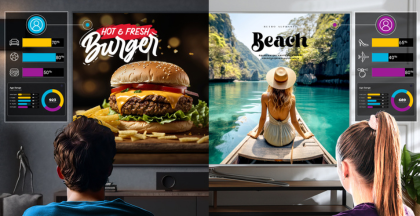SSAI and DAI are current advertising technologies that deliver personalized ads that convert. By implementing such technology, you can generate a significant boost in revenue. Take a moment to go back to the basics to uncover the benefits and best practices of SSAI and DAI.
What are server-side ad insertion (SSAI) and dynamic ad insertion (DAI)?
Server-side ad insertion (SSAI) and dynamic ad insertion (DAI) are two latest advertising technologies that enhance the ad experience for viewers and provide advertisers with more effective ways to reach their target audience. A traditional pay-TV broadcast includes impersonal commercials rolled out to a general audience. However, consumer habits change. Service providers must evolve to a more personalized and customized viewing experience to get better viewer engagement.
Advertisers want to be on every screen, but in the right way, at the right time, to best appeal to the consumer. With data tracking of the target audience, advertisers can deliver more relevant ads, thus increasing impressions and conversions. This is possible by using technologies such as DAI and SSAI. Let’s deep dive into each.
Server-side ad insertion (SSAI)
Server-side ad insertion (SSAI) is the technology that inserts personalized ads and stitches them seamlessly into a single stream. Rather than on the client side (like CSAI), this happens on the server side.
Different users view different ads even if they’re watching the same content on the same day. Viewers receive a continuous stream between fast-loading dynamic ads and content — without buffering or latency between transitions — and back again. That’s why SSAI is also known as server-side dynamic ad insertion.
Dynamic ad insertion (DAI)
Dynamic ad insertion (DAI) allows advertisers to customize ads for each individual user or viewer so they receive highly targeted, personalized offers during live linear programming and VOD.
For example, you can swap outdated commercials for newer ones, and you can target your advertising at many levels leveraging information about geolocalization, socio-demographics, and behavioral profiles per device, per content, and user.
Simplifying ad delivery at scale
SSAI and DAI technologies offer significant simplification and efficiency in ad delivery, especially when reaching a large audience across diverse platforms and devices. Let's explore how these technologies streamline the ad delivery process at scale:
Seamless integration and scalability: By modifying the streaming manifest for each viewer, SSAI ensures that the right ads are dynamically stitched into the content stream, personalized based on the viewer's profile and preferences. This process is highly scalable and can accommodate a multitude of viewers simultaneously, making it ideal for large-scale advertising campaigns and popular content that attracts a massive audience.
Reduced ad operations complexity: SSAI and DAI eliminate the need for manual ad insertion and management, reducing ad operations complexity significantly. Traditional ad insertion methods required managing individual ad placements. With SSAI and DAI, the ad decision-making process is automated, and the right ads are served to each viewer in real time without manual intervention.
Unified ad experience across platforms: Advertisers can use SSAI and DAI to ensure a consistent and unified ad experience for viewers across various platforms and devices. The technology works seamlessly across different streaming platforms, ensuring viewers receive personalized and relevant ads regardless of whether they’re watching on a smart TV, mobile device, or laptop. This unified experience helps strengthen the brand messaging and creates a cohesive advertising campaign.
Real-time optimization: SSAI and DAI enable real-time optimization of ad placements based on user behavior and campaign performance. Through AI-driven algorithms, the technologies can analyze viewer interactions and adjust ad targeting and delivery accordingly. Advertisers can capitalize on real-time insights to refine their campaigns, maximizing ad effectiveness and engagement.
Improved ad viewability and engagement: By eliminating ad blockers' ability to detect or prevent ad playback, SSAI, and DAI ensure that ads are viewable and reach their intended audience effectively. This improved ad viewability and personalized ad experiences enhance viewer engagement. Engaged viewers are likelier to interact with the ads, leading to higher click-through rates, conversions, and overall campaign success.
Efficient ad monetization: For publishers, SSAI and DAI technologies streamline the process of ad monetization. With dynamic ad insertion, publishers can optimize their ad inventory and serve relevant ads to individual viewers, increasing the value of their ad space and attracting more advertisers. This ad delivery and monetization efficiency enhances the revenue potential for content creators and streaming platforms.
SSAI and DAI offer unique solutions to advertisers and content providers, providing viewers with a more seamless and personalized ad experience while optimizing ad effectiveness and revenue generation. As technology continues to evolve, these innovative technologies are expected to shape the future of advertising and user experience in the rapidly expanding world of streaming media.
How does SSAI with DAI work?
The process begins with a streaming manifest - instructions that guide the video player in locating and playing files. SSAI modifies the original streaming manifest for each viewer. Each ad decision will be made in the network and stitched into the content stream before it reaches the viewer’s playback client.
In this step, personalized ads, chosen based on the individual viewer's demographics and preferences (thanks to DAI), get stitched directly into the content stream. Viewers never know that ads have replaced video content because the transition between ads and content is seamless.
This sophisticated synergy between SSAI and DAI ensures that ads reach their intended audience effectively, paving the way for optimal viewer engagement and, consequently, improved returns on advertising spend.
Server-Side Ad Insertion Infrastructure
Components Required for SSAI or DAI Workflow
To set up a server-side ad insertion (SSAI) or dynamic ad insertion (DAI) workflow, several components are necessary:
Content provider: The content provider feeds live or stored video content into the workflow.
Video encoder: The video content goes into an encoder that conditions the video streams based on embedded protocol information (often SCTE-104 or SCTE-35). It is responsible for identifying ad breaks with start and end times in the content stream and inserting cues at the appropriate points.
SSAI module: This component detects ad markers in the video stream. Upon detection, it sends a real-time ad request to the ad decision server. The request contains custom data about the viewer.
Ad decision server: The ad decision server receives the ad request from the SSAI module. It uses the viewer data to modify the original content manifest, inserting chunks of targeted ads into the stream.
Client-side media player: After the relevant ad chunks have been stitched together with the video content, the stream is pushed transparently to the client's media player during ad breaks. The media player sends ad-related data, including views, impressions, and other information to tracking servers and ad partners.
How dynamic ads get into content
SSAI stitches ads and content together on the server side during encoding. A manifest manipulator creates the spliced streams for each playback client. It then makes ad-decision requests, retrieves ads, and inserts them seamlessly in the stream, while streaming. The ads are part of the video stream and proxied from the same server and content delivery network (CDN).
Here’s how it works:
Content ingestion: The process starts with the content provider feeding the video content, which can be stored or live, into a video encoder. The video encoder prepares the video streams and identifies ad breaks within the content.
Ad break identification and cue insertion: The encoder identifies specific ad break points with start and end times within the video stream. Cues are inserted into the playlist at the appropriate points to indicate these ad breaks. These cues mark where the personalized ads will be inserted during playback.
Transcoding and conditioning: The video encoder identifies ad breaks and transcodes and conditions the video streams based on embedded protocol information, such as SCTE-104 or SCTE-35. This ensures the video content and ads can be easily stitched together during playback.
Real-time ad request: As the video content with ad cues reaches the viewer's playback client, the DAI module detects the ad markers and sends a real-time ad request to the ad decision server. This ad request contains custom data about the viewer, including demographic information, viewing history, and preferences.
Ad decision and personalization: The ad decision server receives the ad request and uses the viewer data to make real-time decisions on which ads to serve to that specific viewer. Based on this personalized information, the original content manifest is modified to include chunks of targeted ads.
Seamless integration of ads: The targeted ad file chunks are seamlessly inserted into the content stream at the identified ad break points. As a result, personalized ads become an integral part of the video stream, offering a smooth transition between the content and ads.
Ad delivery to the viewer: Once the content and personalized ads are stitched together, the stream of relevant ad chunks is pushed transparently to the viewer's media player during the ad breaks. From the viewer's media player, ad-related data, including ad views, impressions, and other relevant information, is sent to tracking servers and ad partners, providing valuable insights into the ad's performance.
Manifest manipulation and the cloud
To address the demand for targeted advertising, video providers need media processing platforms that are scalable and flexible. Let’s look at the benefits of cloud-based media processing for DAI to understand why finding a system that supports manifest manipulation is critical to success.
1. Substitute segments dynamically
With adaptive bitrate streaming, encoded content is delivered in different resolutions, bitrates and codecs using bite-sized delivery segments that include video, audio and other data, such as subtitles and timed metadata. These segments are referenced in the manifest, or playlist, used by the OTT player to access server resources.
In the video streaming world, SCTE-35 is a format-agnostic standard to signal an ad break. That ad break is your opportunity to insert a targeted ad within the incoming video stream. Thanks to SCTE-35, segment boundaries can be aligned exactly with the ad insertion points. Ad insertion is achieved by substituting delivery segments. Having a cloud-based server-side DAI solution will give you the most flexibility, allowing you to dynamically substitute ads within live, linear, catch-up TV and recorded content.
2. Sneak by ad blockers
By inserting advertising at the server level (also known as SSAI), advertising and content can be stitched together in the same stream prior to delivery. This helps you counteract ad-blocking software, which is often installed on viewing devices. How? SSAI makes advertisements and content look the same to ad-blocking software, making it difficult to detect ads. SSAI also guarantees a seamless transition and the same quality of experience for content and ads.
3. Create custom manifests
Besides enabling parallel workflows that are scalable, a cloud-centric DAI solution with manifest manipulation allows you to create custom manifests per content, user and device, in real-time. You can support multiple targeting scenarios and deliver unique playlists containing hyper-targeted ads to smartphones, PCs, tablets and connected TVs, and any other device.
You can stretch the use cases for manifest manipulation beyond DAI to include blackout management and video content replacement. Using a cloud-based approach, your entire workflow becomes simpler. Content ABR transcoding, ad transcoding, packaging, manifest generation and manipulation all work together in an end-to-end seamless architecture, eliminating any deployment headaches.
SSAI-supported devices and compatibility
Viewers can access SSAI-supported content across all their devices in both web and app environments. They can stream SSAI content on desktop, and mobile devices including smartphones and tablets, and also connected TVs (CTV). Cloud-based DAI solutions with manifest manipulation support multiple targeting scenarios. Viewers receive unique playlists with hyper-targeted ads that are based on their user data and that also adapt to their current device.
The benefits of SSAI and DAI
Many service providers and OTT companies are reaping the benefits of SSAI and DAI, which include:
Ad block prevention
A significant advantage of an SSAI model for DAI is that its seamless stitching makes advertisements and content look the same to ad-blocking software. Your ads are sure to play, which is the first step to raising brand awareness and converting passive viewers into active buyers.
Dynamic adaptation
Perfectly-timed, relevant ads are one of the best ways to boost customer engagement. Using DAI, ads are planned for a specific time slot but can be switched instantly and dynamically. You can base the DAI configuration on predefined data to best target the viewer. This dynamic adaptation helps deliver the right message at the right time to their target audience. Higher conversion rates result in higher ad value for your business and customers and offer exponential opportunities for revenue growth.
The ideal broadcast viewing experience
Without awkward pauses, connectivity buffering, and annoying return latencies between content and ads, viewers score a high-quality viewing experience that’s as close to broadcast as possible.
High-level data and analytics
Service providers can offer advertisers laser-focused audience segments when they combine cloud-based video processing with big data and behavioral analytics. This target audience refinement process opens the door to smarter, more effective advertising.
Ads are stitched seamlessly into the channel’s theme and as a result, have a higher chance of engagement. This increases your cost per mile (CPM) rate, or what advertisers pay per every 1,000 views of their ad. A brand with a lower CPM may need to run several ads between content, despite potentially upsetting viewers. However, a brand with a higher CPM may decide to limit ads, without reducing revenue, to become more appealing to subscribers.
Your business can use this information to address the increasing demand for personalization to align with viewer expectations. This key insight will help you make more informed decisions regarding creating and testing thematic TV channels, subscription models and pricing tiers, and many other aspects of your business strategy to grow or evolve your video services.
Personalization and multiscreen advertising
New OTT video services from emerging brands and industry giants are popping up every day. All these choices create greater competition when seeking ad dollars. It’s become essential to differentiate your service offering if you want to attract subscribers.
Personalized content is a solution to attract new audiences and retain existing subscribers. Personalization also includes more personalized ads. Over 63% of respondents in one survey admit that they dislike brands blasting generic ad messages that don’t pertain to them. And research shows 67% of Millennials and Gen-Zers believe that offers from companies should “always be personalized.”
Targeted advertising is better received and makes a stronger impression, which in turn raises ad value. DAI solutions can help brands deliver that custom touch that appeals to viewers on a personal level.
SSAI requirements and DAI best practices
Although SSAI and DAI offer many benefits, there are some requirements to know before getting started. To ensure your premium content gets matched up with premium video ads you’ll want to implement these best practices:
Normalize ad triggers
Providers implement in-stream ad triggers in many different ways. So if you’re ingesting live channels from multiple providers, you must process these triggers as they enter the platform. This allows them to be normalized and sometimes enriched with external data.
Ingest ads ASAP
Brands must encode as fast as possible to maximize every opportunity for ad revenue. This means the DAI platform must ingest ads almost instantly. Once ingested, the ad will be transcoded to match the live transcoding profiles to ensure a seamless stitching operation.
However, if your ad transcoding process takes too long, you’ll miss the first opportunities to insert that particular ad. The ad won’t be ingested in time, and you’ll lose the chance to generate impressions.
Accurately report ad performance
Digital advertisers require accurate reporting of ad impressions, including live, catchup, and VOD DAI. Brands must count impressions of each ad and report accurately to the ad server.
Implement Cloud Workflow for Scalability
In the SSAI framework, a manifest is calculated and delivered to each user. This enables different ads to be displayed to different viewers. However, it’s up to the DAI service to process and serve the manifest to each user because the CDN will no longer distribute it. Here’s where the elasticity of a cloud implementation ensures the scalability necessary for deploying DAI.
Track Major DAI/SSAI Metrics for Effectiveness
Ad completion rate measures the percentage of viewers who watched the entire ad without skipping or abandoning it. A higher ad completion rate indicates that the ad content engages and resonates with the audience.
Click-through rate measures the percentage of viewers who clicked on the ad to visit the advertiser's website or landing page. A higher CTR indicates that the ad is compelling and encourages viewers to take action.
Viewability rate measures the percentage of the ad that is visible on the viewer's screen. It ensures that ads are displayed within the viewable area, increasing the likelihood of ad effectiveness.
Ad frequency measures the number of times an individual viewer is exposed to the same ad within a specific time frame. It helps prevent ad fatigue and ensures viewers are not overexposed to the same content.
Return on advertising spend evaluates the revenue generated for every dollar spent on advertising. It indicates the overall effectiveness and efficiency of the ad campaign in driving desired outcomes, such as conversions or sales.
Ad block rate measures the percentage of ad impressions blocked by ad blockers. A lower ad block rate indicates successful circumvention of ad-blocking software through SSAI and DAI, ensuring wider ad reach.
By monitoring and analyzing these metrics, advertisers and content providers can gain valuable insights into the effectiveness of their SSAI and DAI implementations. These metrics also serve as benchmarks for optimizing ad campaigns, enhancing user experience, and achieving better returns on advertising investments.
The role of the vendor in SSAI and DAI
An SSAI vendor sits between your viewers’ online video players and an ad server. The SSAI vendor is responsible for stitching the ads into the video content. It will:
- Identify ad breaks in your stream.
- Transcode content and ads into low, medium, and high-quality versions to allow playback sans buffering at any connectivity level.
- Transcode ads into the right adaptive bit rate (ABR) formats.
- Insert dynamic ads and stitch them and your video content together.
- Relay communication between the video player and the manifest to play the right files at the correct times.
A checklist to compare various SSAI and DAI solutions
Powerful end-to-end capabilities
Solutions that streamline processes are the most efficient for your bottom line. Your team will benefit from a complete DAI solution for live and file-based content from playout to OTT packaging and origin.
Efficient manifest manipulation
Intuitive, easy-to-use feature sets will create fewer headaches for your team. Solutions that interface with ad decision servers and provide a targeted manifest based on user location, device, or more advanced criteria can really help streamline your operational activities.
Simple blackout management
Since OTT content can be distributed to any device, anywhere in the world, you must guarantee compliance with viewing policies. End-to-end video processing and delivery solutions handle event scheduling and offer a notification interface service for smooth blackout management. Check whether your choice can accurately ingest substitute content and slates while providing an updated manifest to ensure legal commitments are fulfilled.
VAST Compliance
Despite SSAI being popularly used in OTT/CTV transactions, the Media Rating Council (MRC) and the Interactive Advertising Bureau (IAB) say SSAI is prone to looking similar to “faked traffic fraud.” So they designed the Video Ad Serving Template (VAST) video format to standardize communication between video players and servers. This makes it easier for traffic across different publishing platforms.
Since all video ads used with DAI must be VAST-compliant, it’s important that your service partners are knowledgeable in these best practices and follow these guidelines.
Implement SSAI and DAI with Harmonic’s cloud-based solution
DAI is best deployed with a cloud-based approach. Your team’s entire workflow can become simpler in the cloud. Content ABR transcoding, ad transcoding, packaging, manifest generation, and manipulation all happen together in a seamless end-to-end architecture to eliminate deployment challenges.
While these types of cloud-based approaches are a new trend and in their early phases of adoption, the progression of these technologies mirrors appliance products for CiaB (channel in a box). The difference is that cloud-based is 100% software by nature, and offers all of the above-mentioned workflows which could radically reduce the need for dedicated appliances. Harmonic’s advanced cloud-based solution, VOS®360 Ad, comes with a range of advertising technology that includes SSAI, DAI and more.
Better optimize advertising market share today
SSAI and DAI enable ad replacement in live streams while providing a seamless, less disruptive experience for your viewers. This advanced video ad stitching on the server side also reduces potential threats from ad-blocking tools, as video ads appear just like regular content. The end result leads to greater ad value, higher ad revenue, and a better viewing experience.
Do you have questions about the best SSAI and DAI solutions for your business? Let us know, and we’ll be happy to start a discussion.











